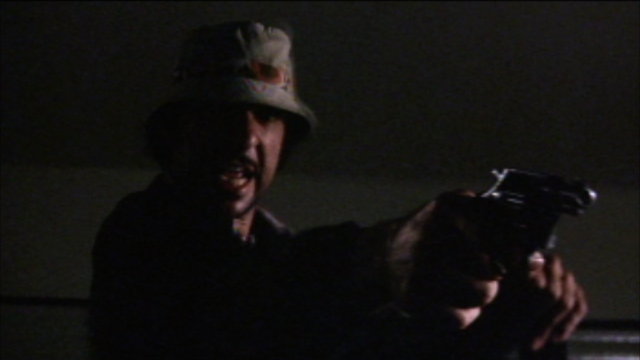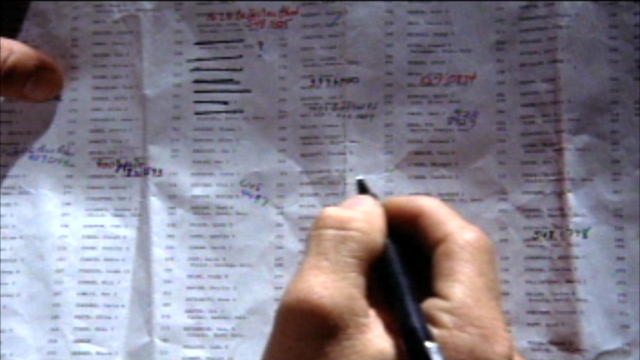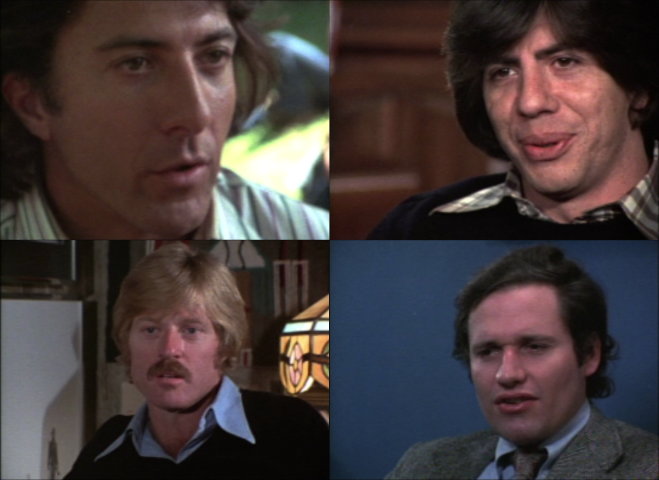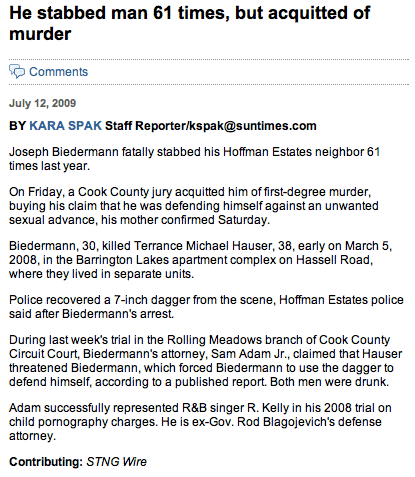Mimsy Review: All the President’s Men
“The truth is, these are not very bright guys, and things got out of hand.”
Special features
| Commentary Track | 8 |
|---|---|
| Featurette | 7 |
| History Lesson | 7 |
| Interviews | 8 |
| Making Of | 7 |
| Related Trailers | 6 |
| Trailer | 5 |
Probably one of the most influential events in journalism history made into one of the best films of the seventies.
| Recommendation | Purchase Now!• |
|---|---|
| Director | Alan J. Pakula |
| Writer | William Goldman |
| Movie Rating | 8 |
| Transfer Quality | 7 |
| Overall Rating | 8 |
| Formats |
|

“He’s a nice person. He’s secretive. But a decent man.” The real story behind Watergate is the invisible army of attractive young secretaries in DC.
One of my earliest memories is of my favorite afternoon cartoons preempted by some sort of “watergate” breaking in Washington. I tried to watch it a few times, but there was no water and no gate. It was nothing but a bunch of old men standing up and sitting down.
The Watergate scandal has become part of our country’s journalistic mythology. No scandal is serious until it merits the dreaded -gate suffix. Woodward and Bernstein themselves are, as Jason Robards said in the movie, two faces of one man. Or as Garry Trudeau had David Halberstam say in a spring 1979 Doonesbury, “Gods. I kiss their Guccis.•”
All the President’s Men begins with real footage of the Nixon administration’s first term, his “triumphant return from China”. The film takes place over that first term and follows through the 1972 primaries when McGovern’s campaign imploded. The campaign is never discussed, but we see it on the televisions in the Post newsrooms.
The movie proper starts with the infamous Watergate break-in. It starts looking like a police story, with two plainclothes cops called in for what sounds to them like a routine burglary, but that we see as a complex intelligence operation. It sets the stage for a standard crime thriller—until the burglars turn out to be well-connected and two cub reporters take over. We never see the police again.

Wrong movie, Serpico.
Since everyone seeing the movie in 1976 already knew it was about two reporters, this couldn’t have been an attempt at tricking the audience. It might have been an attempt to contrast with the Serpico-style movies coming out then, but I’m guessing it was also emphasizing a new era of corruption enforcement. This bust was by journalists. “The only weapon these guys have when they travel is their notebooks… It’s a new era.”
On the commentary, Redford describes the lighting choices this way:
The light was only in the newsroom. It was broad, bright fluorescent light. There were no shadows, nothing could be hidden. And that’s where the truth emerged, out of the dark.
And it is a new era; in many ways a good one, but All the President’s Men also highlights the wrong turn journalism took after Watergate. Their story hinged on a highly placed anonymous source. They could not have written their stories without the starting points Deep Throat provided. Deep Throat became a journalism god along with Woodward and Bernstein themselves. In the process of deifying Deep Throat, anonymous sources were legitimized as primary, quotable sources.
Too often today an anonymous source appears to be the end of a reporter’s investigation instead of the beginning. How often have you read a story with “anonymous sources state” and the claim is one that the reporter should have been able to confirm with a simple phone call or two?
The use of unconfirmed statements as if all that’s required is someone said them has spread to non-anonymous sources that might as well be anonymous. Look at this from The Chicago Sun-Times that came across while I was writing this review.
“His mother confirmed” the outcome of the trial? Unless his mother works for the court that’s not a confirmation, that’s a claim. And it’s an easy claim to verify: call the court and ask.
I think reporters emulate the Watergate articles and books without any idea how much work went into cultivating trustworthy sources and how much work is required to verify sources.
Using unverified quotes from anonymous sources is a whole lot easier than going door-to-door from a list of a hundred names whose addresses you got from a phone book. They don’t see the work, they see easy money. Woodward and Bernstein’s job wasn’t easy.
You can’t just call up this guy Steve who claimed to be an insider at last night’s party, ask him for an anonymous quote, and assume the quote is worthwhile. It’s poor journalism to simply write “sources state” without verifying both the source’s and the statement’s reliability.
Hollywood doesn’t always know what to do with movies like this. The cover of the DVD is a still, I assume, of Redford and Hoffman looking heroically into the distance. There is no scene like that in the movie.1 Part of the point of the movie is that they were just a couple of guys doing a job that needed to be done.
The tagline on the poster and in the trailer says “it might cost them their lives.” That doesn’t appear in the movie either until the movie ends. The movie ends very abruptly. Just when the excitement builds-everyone’s life is in danger-it switches to a montage of typewriters and the movie is over. As much as I loved the movie that was an odd choice. It was something Redford (who is responsible for the movie’s birth) was adamant about; it helped keep the movie’s focus on these “two schlubs plodding along… tiny figures against the monumental structures of Washington”.
The first DVD also contains a commentary by Robert Redford, the producer and driving force behind the movie. He leaves a lot of blank time in the commentary, but when he does talk about a scene, it’s interesting. He tends to talk about the relationship between Woodward and Bernstein and the acting; and between what actually happened and how that affected their choices in filming it. He also sets it in context with what they’re trying to say with the movie.
There are also some very nice extras on the second DVD. There’s a nice, if self-serving (the voice-over sounds like a government ad from the thirties), companion piece from 1976, with Redford, Hoffman, Woodward, Bernstein, and a few others, conducted during and after the making of the movie. It’s about the events that led to the making of the movie as much as about the movie itself. It’s nice to see relatively sustained segments with Woodward and Bernstein from the seventies.
There’s also a short interview with Jason Robards on the May 27, 1976 Dinah! shortly after Dinah Shore saw the movie. Slightly interesting; what you’d expect from a seventies talk show.

Telling the Truth About Lies is about the making of the movie: how the actors, director, and cinematographer were chosen, and some interviews with them now talking about them then. Cinematographer Gordon Willis has some of the most interesting things to say in this short, about the contrasts from scene to scene.
Then there’s a paean to investigative journalism. “Woodward and Bernstein: Lighting the Fire” could have been bad; instead it was fascinating. Journalists apparently do enjoy the movie. Greg Krikorian of the Los Angeles Times said, “I can’t tell you how many journalism conferences I’ve been to where they have shown All the President’s Men because they wanted to have the journalists re-energized about what they can accomplish.”
Jonathan Alter describes the good and the bad legacies of Watergate: “A lot of reporters thought that it was their job to do gotcha stories; that was the bad legacy. The good legacy, which I think we’re now losing, is accountability in government.” There’s too much gotcha going around.
Much of this piece was about “investigative” journalism. Bernstein was a little leery of the title.
I’m not a reporter who thinks that so-called “investigative” journalism necessarily is different from the rest of journalism. It seems to me that all good reporting is pretty much the same thing, the best obtainable version of the truth.
It also includes people like Walter Cronkite and Linda Ellerbee. Well worth watching.
And finally, since the DVD came out after Mark Felt revealed his identity as Woodward and Bernstein’s most famous anonymous source, they were able to include a segment on him. “Out of the Shadows: The Man Who Was Deep Throat” talks about Felt from the point of view of Woodward and Bernstein, and talks about the mystery of Deep Throat from the point of view of Ben Bradlee, scriptwriter William Goldman, and others.
All of these extras (except the ones from the seventies) were narrated by Hal Holbrook, whose voice is made for narration.
This is a great movie, well worth re-watching, and this DVD has some fine extras. I recommend it.

I assume the still is real; you can imply all sorts of things by freezing frames mid-action, as we’ve seen repeatedly over the last several years.
↑
Recommendation: Purchase Now!•
| Director | Alan J. Pakula |
|---|---|
| Writer | William Goldman |
| Based on | All the President’s Men• |
| Actors | Dustin Hoffman, Robert Redford, Jack Warden |
| Length | 2 hours, 18 minutes |
| Spoken language | English |
| Subtitles | English, French, Spanish |
| Special Features | Commentary Track, Featurette, History Lesson, Interviews, Making Of, Related Trailers, Trailer |
| More links |
If you enjoyed All the President’s Men…
For more about conspiracy, you might also be interested in Capricorn One, Men in Black, and Wag the Dog.
For more about Dustin Hoffman, you might also be interested in Hook and Wag the Dog.
For more about Jack Warden, you might also be interested in Bulworth.
For more about journalism, you might also be interested in Kolchak: The Night Stalker (TV Series), Call Northside 777, The President’s freelancers, Confirmation journalism and the death penalty, Fighting for the American Dream, Mike Royko: A Life in Print, The World of Mike Royko, Fit to Print: A.M. Rosenthal and His Times, A Reporter’s Life, Deadlines & Monkeyshines: The Fabled World of Chicago Journalism, Inside the Beltway: A Guide to Washington Reporting, Letters to a Young Journalist, The Elements of Journalism, All the President’s Men, The First Casualty, Scoop, Release: The Dream of Poor Bazin, and Are these stories true?.
For more about seventies, you might also be interested in Almost Famous, Boogie Nights, Detroit Rock City, Dick, North Dallas Forty, Better for being ridden: the eternal lie of the anointed, Plain & Fancy in the seventies with Hiram Walker, A Bicentennial Meal for the Sestercentennial, Hobby Computer Handbook: From 1979 to 1981, and Hesperia Class of ’82.
For more about Watergate, you might also be interested in Dick, The Palace Guard, and All the President’s Men.
- Alan J. Pakula at Wikipedia
- “Pakula started his Hollywood career as an assistant in the cartoon department at Warner Brothers. In 1957, he undertook his first production role for Paramount Pictures. In 1962, he produced To Kill a Mockingbird, for which he was nominated for a Best Picture Academy Award. In 1969, he directed his first feature, The Sterile Cuckoo.”
- All the President’s Men• (DVD)
- A fascinating glimpse into the Watergate investigation by Woodward and Bernstein.
- All the President’s Men
- “ At times it looked like it might cost them their jobs, their reputations, and maybe even their lives.”
- All the President’s Men•: Bob Woodward and Carl Bernstein (paperback)
- “Beginning with the story of a simple burglary at Democratic headquarters, Bernstein and Woodward kept the tale of conspiracy and the trail of dirty tricks and dark secrets coming—delivering the stunning revelations and pieces in the Watergate puzzle that brought about Nixon's scandalous downfall. Their explosive reports won a Pulitzer Prize for The Washington Post and toppled the President. This is their book that changed America.”
- Dustin Hoffman at Wikipedia
- “Hoffman began acting at the Pasadena Playhouse with Gene Hackman. After two years at the playhouse, Hackman headed for New York City, and Hoffman soon followed.” The Graduate started his career in earnest; he went on to cement his career with parts in Midnight Cowboy, Little Big Man, and All the President’s Men.
- He stabbed man 61 times, but acquitted of murder: Kara Spak
- “On Friday, a Cook County jury acquitted him of first-degree murder, buying his claim that he was defending himself against an unwanted sexual advance, his mother confirmed Saturday.”
- Jack Warden at Wikipedia
- “In 1944, on the eve of the D-Day invasion, Staff Sergeant Warden shattered his leg by landing on a fence during a night-time practice jump in England. After almost a year in the hospital (during which time he read a Clifford Odets play and decided to become an actor after the end of the war), he recovered enough to participate in the Battle of the Bulge in 1944.
- The People’s Doonesbury•: G. B. Trudeau (paperback)
- Satire can only be as funny as it reflects real life. Satires of straw men are more pathetic than funny, and here Trudeau begins to fall into a habit of “headline satire” that fails to be satire. But this book collects strips that are still more funny than not. Includes strips from 1978 through 1980.
- Robert Redford at Wikipedia
- “During the years 1974-76, exhibitors voted Redford Hollywood’s top box office name. His hits included The Great Gatsby, The Great Waldo Pepper and Three Days of the Condor. The popular and acclaimed All the President's Men, directed by Alan J. Pakula, was a landmark film for Redford. Not only was he the executive producer and co-star, but the film's serious subject matter, the Watergate scandal, also reflected the actor's offscreen concerns for political causes.”
- William Goldman at Wikipedia
- “According to Goldman's memoir, Adventures in the Screen Trade, Goldman began writing when he took a creative writing course in college. He did not originally intend to become a screenwriter. His main interests were poetry, short stories, and novels. William Goldman published five novels and had three plays produced on Broadway before he began to write screenplays. He wrote mostly serious literary works until the death of his first agent when he then began writing thrillers starting with Marathon Man.”



“You operate in a world of doubt, and you have to be doubtful yourself of what people are saying.”—Bob Woodward•